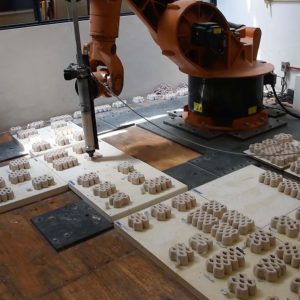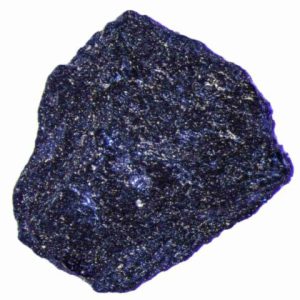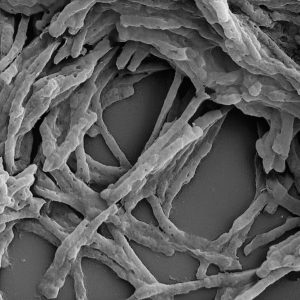Link About It: This Week’s Picks
Mushroom computers, eggshell bricks, electricity from air and more

Creating Computers Out of Mushrooms
 Researchers at the Unconventional Computing Laboratory are exploring the potential to build computers out of living systems in order to create more complex machines. Current technology operates in binaries despite the fact that much of the world is more multidimensional. In comparison, computers potentially made from fungi—with its intricate, branching structure—could offer a new way of processing information. To create them, researchers have tapped into the communicative properties of mycelium, which already conducts electricity and operates its own wireless communication with the environment. Similar to how brain cells form habits, mycelium—when stimulated at separate points—forms faster communication built from memory. “We found actually that mushrooms produce action potential-like spikes. The same spikes as neurons produce,” says the lab’s director Andrew Adamatzky who plans to use this discovery to build “a brain from mushrooms.” Learn more at Popular Science.
Researchers at the Unconventional Computing Laboratory are exploring the potential to build computers out of living systems in order to create more complex machines. Current technology operates in binaries despite the fact that much of the world is more multidimensional. In comparison, computers potentially made from fungi—with its intricate, branching structure—could offer a new way of processing information. To create them, researchers have tapped into the communicative properties of mycelium, which already conducts electricity and operates its own wireless communication with the environment. Similar to how brain cells form habits, mycelium—when stimulated at separate points—forms faster communication built from memory. “We found actually that mushrooms produce action potential-like spikes. The same spikes as neurons produce,” says the lab’s director Andrew Adamatzky who plans to use this discovery to build “a brain from mushrooms.” Learn more at Popular Science.
Image courtesy of Andrew Adamatzky
3D-Printing Bricks From Discarded Eggshells
 Mexican multidisciplinary design studio MANUFACTURA devised a new way to create building materials from discarded eggshells. The team used locally-sourced food waste (collected from donations and nearby restaurants) that, when combined with bio-binders, became a thick material compatible with 3D printers. The eco-friendly method then merged digital manufacturing and computational design to create an eggshell brick, from which a wall can be formed (composed of 105 different blocks) or a column (from 26 pieces). The initiative, dubbed the Eggshell Project, tackles not only the unsustainable methods of the construction industry, but also excessive food waste in Mexico. Learn more and see additional photos of the process at Interesting Engineering.
Mexican multidisciplinary design studio MANUFACTURA devised a new way to create building materials from discarded eggshells. The team used locally-sourced food waste (collected from donations and nearby restaurants) that, when combined with bio-binders, became a thick material compatible with 3D printers. The eco-friendly method then merged digital manufacturing and computational design to create an eggshell brick, from which a wall can be formed (composed of 105 different blocks) or a column (from 26 pieces). The initiative, dubbed the Eggshell Project, tackles not only the unsustainable methods of the construction industry, but also excessive food waste in Mexico. Learn more and see additional photos of the process at Interesting Engineering.
Image courtesy of MANUFACTURA
New Superconductor Works At Room Temperature
 Since the discovery of superconductors—materials that conduct electricity without resistance—back in 1911, their use has always been limited by the fact that they only work at below-freezing temperatures. A groundbreaking new study reports the discovery of a superconductor capable of working at room temperature, which not only liberates the material from its historic constraints but also opens doors to new applications of electric energy (for instance, levitating trains). This new superconductor is composed of the rare earth metal lutetium, hydrogen and a bit of nitrogen that is then compressed to a pressure of 14,500 pounds per square inch. According to the study, this composition can create superconductors that work at 70 degrees Fahrenheit. Learn more about this development at The New York Times.
Since the discovery of superconductors—materials that conduct electricity without resistance—back in 1911, their use has always been limited by the fact that they only work at below-freezing temperatures. A groundbreaking new study reports the discovery of a superconductor capable of working at room temperature, which not only liberates the material from its historic constraints but also opens doors to new applications of electric energy (for instance, levitating trains). This new superconductor is composed of the rare earth metal lutetium, hydrogen and a bit of nitrogen that is then compressed to a pressure of 14,500 pounds per square inch. According to the study, this composition can create superconductors that work at 70 degrees Fahrenheit. Learn more about this development at The New York Times.
Image by J Adam Fenster, courtesy of University of Rochester
Recycling Cotton Waste By Putting It Back in the Soil
 In a new creative trial, farmers in Gunnedah and Goondiwindi (towns in Queensland and New South Wales, Australia) have embedded shredded cotton bedsheets and clothing into their soil to recycle fiber waste and remove CO2 from the atmosphere. Of the 20 metric tons of waste buried in the ground, farmers discovered that for every 2.3 of them, 2.07 metric tons of carbon were avoided due to the fabric breaking down in the soil. This also improves crops because it decreases the nitrogen levels in the soil, potentially halting fertilizer from escaping into waterways. “We send to landfill 800,000 [metric tons] of textiles in Australia each year, and some of that will be 100 percent cotton. If they can be reused, that’s a preferable solution, but this is a preferred pathway for absolute end-of-life textiles,” says Jaine Morris, founder of the circular economy project Coreo. Learn more at Cosmos.
In a new creative trial, farmers in Gunnedah and Goondiwindi (towns in Queensland and New South Wales, Australia) have embedded shredded cotton bedsheets and clothing into their soil to recycle fiber waste and remove CO2 from the atmosphere. Of the 20 metric tons of waste buried in the ground, farmers discovered that for every 2.3 of them, 2.07 metric tons of carbon were avoided due to the fabric breaking down in the soil. This also improves crops because it decreases the nitrogen levels in the soil, potentially halting fertilizer from escaping into waterways. “We send to landfill 800,000 [metric tons] of textiles in Australia each year, and some of that will be 100 percent cotton. If they can be reused, that’s a preferable solution, but this is a preferred pathway for absolute end-of-life textiles,” says Jaine Morris, founder of the circular economy project Coreo. Learn more at Cosmos.
Image courtesy of Kimberly Vardeman/Flickr
Converting Air Into Electricity
 Scientists from Monash University in Melbourne, Australia have discovered an enzyme called Huc converts air into electrical energy. With the potential to create limitless clean energy, the enzyme (which is found in common soil bacterium Mycobacterium smegmatis) consumes hydrogen in the air and turns it into electrical currents. The process is efficient and stable, and Huc can be grown in large quantities, making it a promising breakthrough for sustainability. “Once we produce Huc in sufficient quantities, the sky is quite literally the limit for using it to produce clean energy,” says lead researcher Dr Rhys Grinter. Learn more about the study and the potential to create alternative, natural batteries at The New Daily.
Scientists from Monash University in Melbourne, Australia have discovered an enzyme called Huc converts air into electrical energy. With the potential to create limitless clean energy, the enzyme (which is found in common soil bacterium Mycobacterium smegmatis) consumes hydrogen in the air and turns it into electrical currents. The process is efficient and stable, and Huc can be grown in large quantities, making it a promising breakthrough for sustainability. “Once we produce Huc in sufficient quantities, the sky is quite literally the limit for using it to produce clean energy,” says lead researcher Dr Rhys Grinter. Learn more about the study and the potential to create alternative, natural batteries at The New Daily.
Image courtesy of Wikimedia Commons
Link About It is our filtered look at the web, shared daily in Link and on social media, and rounded up every Saturday morning. Hero image courtesy of Kimberly Vardeman/Flickr












